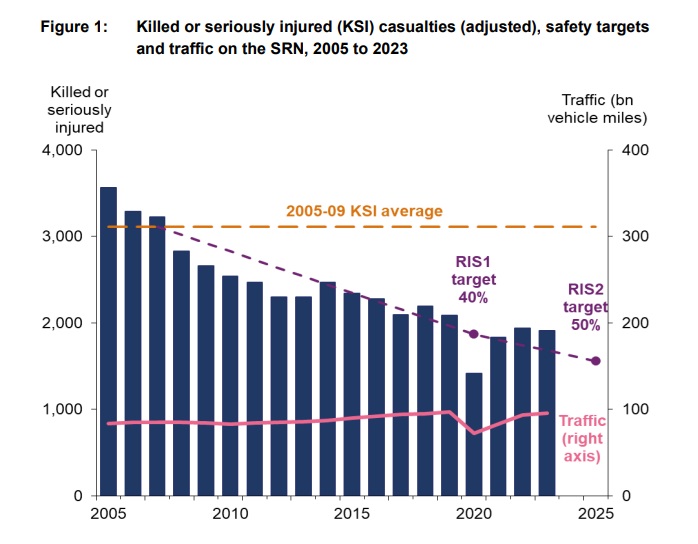National Highways has so far only implemented half of the actions it promised last March to cut casualties on its network and remains likely to miss its safety target for the current roads period, its regulator has said.
The Office of Road and Rail’s (ORR) third annual assessment of safety on the strategic road network (SRN) assesses the company’s safety performance during 2023 and its actions to improve smart motorway safety.
The report shows that safety on the SRN continues to improve, with the latest data showing the lowest number of people killed or seriously injured (KSI) ever recorded, except when traffic volumes were significantly lower due to the pandemic, and the lowest ever casualty rate per mile travelled, excluding 2020.
However, National Highways has a target of a 50% reduction in KSIs by the end of 2025, compared to a 2005-09 average baseline. As has previously been reported, there were 1,913 KSIs on the SRN in 2023, meaning that the company has so far only achieved a 39% reduction.
The ORR noted that the company remains off-course to achieve a 50% reduction.

It noted that in its last (2023) annual safety report it required National Highways to set out a plan for how it would achieve the target, resulting in an enhanced safety plan with 43 actions that the company proposed to deliver in the final year of the second roads period, i.e. this month.
The ORR had originally used the word 'robust' to describe the plan that it required the company to produce but omitted this word from its description of the plan in its new report.
In fact, the report discloses that at the end of February 2025, National Highways had delivered just 22 interventions but said it ‘expects’ to deliver a further 10 by the end this month, with 11 planned to be delivered later in 2025.
The ORR said the company’s safety plan included 24 road safety schemes, eight communications campaigns, and 11 'working with others' actions to develop safety interventions in partnership with other stakeholders.
Despite previously promising to hold National Highways to account for delivering the plan, the ORR again repeated its assessment that the company ‘is doing everything it reasonably can in the final year of the road period’ and said its ability to deliver some proposed interventions ‘has been affected by events outside of its control’.
It said a November 2024 government mandate for a reduction in budgets for communication campaigns cut National Highways’ overall communications budget by 50%, which saw it scale back some planned activities.
However, this would only have affected actions that it had still not implemented at that time.
The ORR repeated concerns that National Highways did not do enough to improve safety during the 2020-25 roads period and said National Highways should provide it with details of the actions it took at that time ‘and sets out the evidence it used to identify why these were the most effective interventions at the time’.
Feras Alshaker, the ORR’s director, performance and planning, said: ‘It is a good thing that that safety continues to improve on the strategic road network, and we should recognise the work that National Highways has been doing to improve safety on its roads.
‘National Highways must now focus on implementing the remaining actions from its plan to further improve road user safety.’
National Highways said it had implemented more than 200 safety schemes during this road period, adding that while the number of deaths or serious injuries has reduced, it recognizes that this may not be enough to meet its target.
A spokesperson said: ‘We’re doing everything in our control to make sure our roads re even safer. That’s why we have an enhanced safety plan, and we are working closely with organisations across the sector to help us reduce deaths and serious injuries.’





